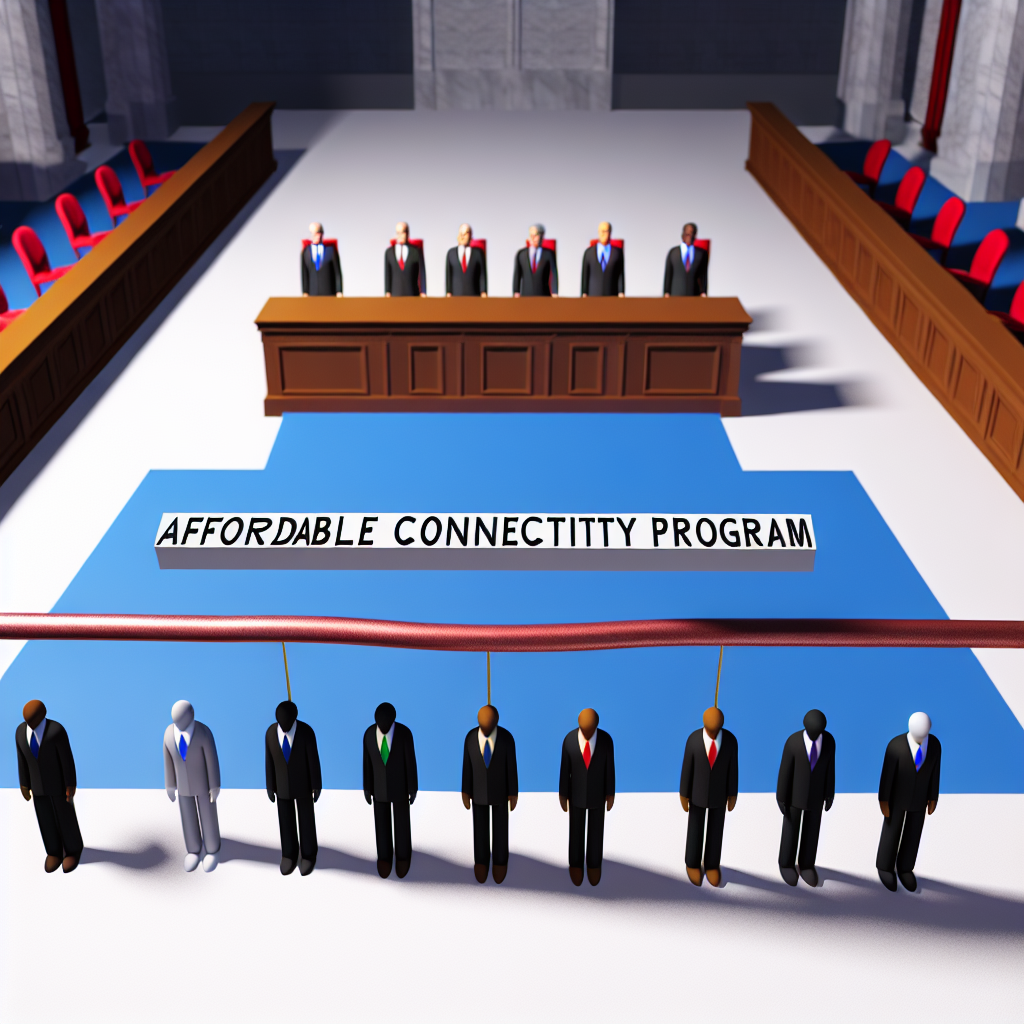The Benefits of the Affordable Connectivity Program for Underserved Communities
The Affordable Connectivity Program, a proposed initiative aimed at providing affordable internet access to underserved communities, has found a lifeline in the Senate. This program, if implemented, could have a transformative impact on these communities by bridging the digital divide and opening up a world of opportunities for their residents.
One of the key benefits of the Affordable Connectivity Program is its potential to address the issue of internet affordability. In many underserved communities, the cost of internet service is prohibitively high, making it difficult for residents to access the online resources they need. This lack of affordable connectivity creates a significant barrier to education, employment, and other essential services.
By subsidizing the cost of internet service, the Affordable Connectivity Program would make it more accessible and affordable for individuals and families in underserved communities. This would enable students to access online educational resources, job seekers to search for employment opportunities, and residents to connect with healthcare providers through telemedicine. The program would empower these communities by providing them with the tools they need to thrive in the digital age.
Another benefit of the Affordable Connectivity Program is its potential to promote economic development in underserved areas. Access to affordable internet service is increasingly essential for businesses to thrive in today’s digital economy. However, many small businesses in underserved communities struggle to afford reliable internet connections, limiting their ability to compete and grow.
By expanding access to affordable internet service, the program would level the playing field for these businesses. It would enable them to reach a broader customer base, engage in e-commerce, and take advantage of online marketing opportunities. This increased connectivity would not only benefit individual businesses but also contribute to the overall economic growth of underserved communities.
Furthermore, the Affordable Connectivity Program would have a significant impact on education in underserved areas. The digital divide has long been a barrier to educational equity, with students in underserved communities lacking access to the same online resources and opportunities as their peers in more affluent areas. This disparity has only been exacerbated by the COVID-19 pandemic, which forced many schools to transition to remote learning.
By providing affordable internet access to these communities, the program would help bridge this educational divide. Students would be able to access online learning platforms, research materials, and educational resources that are essential for their academic success. This increased connectivity would not only improve educational outcomes but also empower students to pursue higher education and career opportunities that were previously out of reach.
In conclusion, the Affordable Connectivity Program has the potential to bring about significant benefits for underserved communities. By addressing the issue of internet affordability, the program would enable residents to access essential services, promote economic development, and bridge the educational divide. It is crucial for the Senate to support and pass this initiative, as it has the power to transform the lives of millions of individuals and uplift entire communities.
How the Affordable Connectivity Program Can Bridge the Digital Divide

The digital divide has long been a pressing issue in our society, with millions of Americans lacking access to affordable and reliable internet connectivity. This divide has only been exacerbated by the COVID-19 pandemic, as remote work, online learning, and telehealth services have become the new norm. However, there is hope on the horizon with the introduction of the Affordable Connectivity Program in the Senate.
The Affordable Connectivity Program aims to bridge the digital divide by providing affordable internet access to low-income households. It recognizes that internet connectivity is no longer a luxury but a necessity for full participation in today’s society. By ensuring that all Americans have access to affordable internet, the program seeks to level the playing field and create equal opportunities for all.
One of the key features of the Affordable Connectivity Program is its focus on affordability. It recognizes that cost is a significant barrier for many low-income households, and therefore, it aims to provide subsidies and discounts to make internet access more affordable. This will not only benefit individuals and families but also small businesses and entrepreneurs who rely on the internet for their livelihoods.
Another important aspect of the program is its emphasis on reliability. It acknowledges that simply providing internet access is not enough; it must be reliable and of sufficient quality to meet the needs of users. The program will work with internet service providers to ensure that the connectivity provided is not only affordable but also reliable, with minimum standards for speed and performance.
In addition to affordability and reliability, the Affordable Connectivity Program also recognizes the need for digital literacy and skills training. It understands that access to the internet alone is not enough; individuals must also have the knowledge and skills to make the most of it. The program will invest in digital literacy programs, providing training and resources to help individuals navigate the online world and take advantage of the opportunities it offers.
The introduction of the Affordable Connectivity Program in the Senate is a significant step forward in bridging the digital divide. It shows that policymakers are recognizing the importance of internet access and are taking concrete steps to address the issue. By providing subsidies, ensuring reliability, and investing in digital literacy, the program has the potential to make a real difference in the lives of millions of Americans.
However, it is important to note that the program still faces challenges. One of the main challenges is funding. Providing affordable internet access to millions of households requires significant financial resources. The program will need the support of Congress to secure the necessary funding and ensure its successful implementation.
Another challenge is the coordination and collaboration between different stakeholders. Bridging the digital divide requires the involvement of internet service providers, government agencies, community organizations, and individuals themselves. The program will need to foster partnerships and cooperation to ensure that everyone is working towards the same goal.
Despite these challenges, the Affordable Connectivity Program offers a lifeline to those who have been left behind in the digital age. It recognizes the importance of internet access in today’s society and seeks to ensure that no one is left behind. With the support of the Senate and the commitment of all stakeholders, the program has the potential to bridge the digital divide and create a more inclusive and equitable society.
The Potential Impact of the Affordable Connectivity Program on Education and Economic Opportunities
The Affordable Connectivity Program, a key component of President Biden’s infrastructure plan, has received a lifeline in the Senate. This program aims to bridge the digital divide by providing affordable internet access to low-income households. While the program has garnered support from both sides of the aisle, its potential impact on education and economic opportunities is particularly noteworthy.
Access to reliable internet has become increasingly crucial in today’s digital age. However, many low-income households struggle to afford internet services, leaving them at a disadvantage in various aspects of life. The Affordable Connectivity Program seeks to address this issue by offering subsidies to eligible households, making internet access more affordable and accessible.
One area where the program could have a significant impact is education. With the COVID-19 pandemic forcing schools to shift to remote learning, the lack of internet access has disproportionately affected students from low-income backgrounds. Without reliable internet, these students struggle to participate in online classes, complete assignments, and access educational resources. The Affordable Connectivity Program could level the playing field by ensuring that all students have equal access to educational opportunities, regardless of their socioeconomic status.
Moreover, the program could also enhance economic opportunities for low-income individuals and communities. In today’s digital economy, many job opportunities require basic digital skills and access to the internet. However, without affordable connectivity, individuals from low-income backgrounds are often left behind. By providing affordable internet access, the program could empower these individuals to search for jobs, access online training programs, and participate in the digital economy. This, in turn, could help reduce income inequality and promote economic mobility.
Furthermore, the Affordable Connectivity Program could also benefit small businesses and entrepreneurs. In an increasingly digital marketplace, having a strong online presence is crucial for business success. However, many small businesses in low-income communities struggle to afford internet services, limiting their ability to reach customers and expand their operations. By making internet access more affordable, the program could enable these businesses to compete on a level playing field, fostering economic growth and revitalizing underserved communities.
While the potential impact of the Affordable Connectivity Program on education and economic opportunities is promising, there are still challenges to overcome. One such challenge is ensuring that the program reaches those who need it the most. Efforts must be made to identify and target eligible households, particularly in underserved areas. Additionally, there is a need for ongoing support and resources to help individuals and communities make the most of the program’s benefits. This could include digital literacy training programs and technical assistance for small businesses.
In conclusion, the Affordable Connectivity Program has the potential to make a significant impact on education and economic opportunities. By providing affordable internet access to low-income households, the program could bridge the digital divide and empower individuals and communities. From leveling the playing field in education to enhancing economic opportunities for small businesses, the program could help create a more equitable and inclusive society. However, it is crucial to address implementation challenges and provide ongoing support to ensure the program’s success. With the lifeline it has received in the Senate, the Affordable Connectivity Program is one step closer to becoming a reality and transforming lives for the better.


